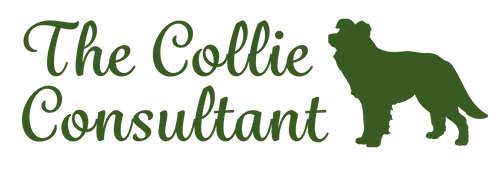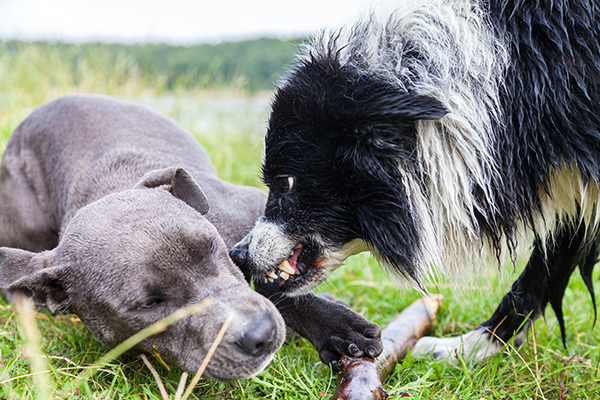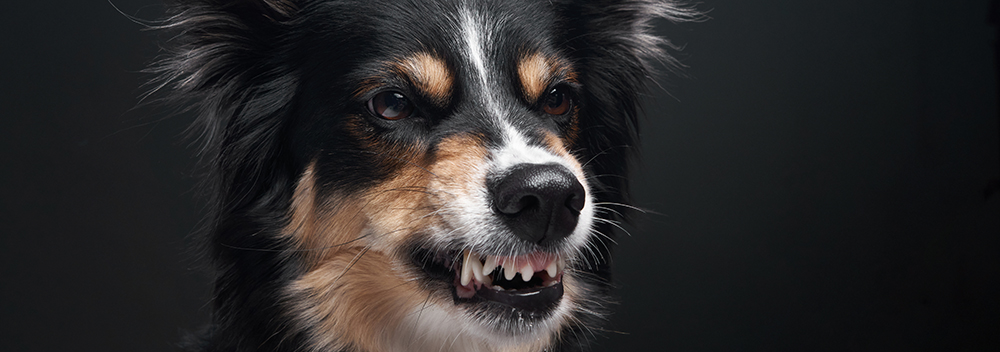
Border collie aggressive behaviour is one of the most frequent behaviour problems that I am asked about, but there is rarely one cause or one training plan that fits all collies. Aggressive behaviour generally includes growling, barking, lunging, snarling, nipping, snapping or biting. As behaviourists, we always need to find out why the dog is behaving aggressively. Just changing the dog’s behaviour by using training without knowing the emotion behind the behaviour, won’t be successful over the longer term. Collies can start to behave aggressively due to the following emotional reactions:
- Fear
- Frustration
- Pain
- Seeking of food, exercise, affections, anything that the dog wants
- Attachment to the owner
- Play
- Sexual motivations
- Care – treating the owner as they would a young puppy (this is rare)
This article about border collie aggression goes into this in more detail. In this blog post I’m going to focus on how we typically work with adolescent border collies who exhibit aggressive behaviour due to fear.
Collies are often very sensitive and can become fearful of people, other dogs or traffic, causing them to react by growling, barking or lunging. This often starts at adolescence when, due to various hormones and other changes that are taking place in the brain and body of the dog, they can go through a fear period. In fear periods, relatively minor things that usually wouldn’t affect a dog can cause a lasting trauma and cause a collie to become fearful. With careful handling, we can usually help an adolescent dog overcome these fears to a certain extent. However, we always need to remember that aggression is a natural behaviour and we can never say that an aggressive dog is “cured”.
Risk
The most important part of any border collie aggressive behaviour training plan will be to ensure that everyone stays safe. Risk can include risk to members of the public and their dogs, risk of prosecution to the owner (always be aware of the Dangerous Dogs Act 1991), risk of being pulled into the road by a dog reacting to traffic and to road users by to causing an accident. And, of course, risk to the dog itself. We always have to be sure that everyone is safe. This may mean muzzle training your dog. I always advise that all dogs are muzzle trained – a dog in pain is likely to be aggressive and you never know what is going to happen to your dog in the future. If they are injured and in pain and we have to stick an unfamiliar muzzle on them, an awful situation becomes even more terrifying.
Prevent your collie from practising the aggressive behaviour
Depending on each individual dog and owner’s unique circumstances, each behaviour plan varies slightly. However, the first step is always to try to prevent the dog from practising the behaviour. This is because the more a dog practises a behaviour, the more they will perform the behaviour – it’s like learning to play a musical instrument, the more we do it, the easier it becomes. It’s just the same for dogs, they see something that triggers the behaviour, and they just react aggressively without thinking. We need to break this habit and start to help them learn to use new behaviours as well as changing their emotional reaction to the trigger which will make their “new” non-aggressive behaviour easier to practise.
So walking dogs in wide open spaces where they can keep at a suitable distance away from your dog’s triggers is key. Owners need to avoid narrow alleys and corners as much as possible unless you have a helper to check it out first.
It’s also important to understand that tightening the lead, especially if the dog is being walked on just a neck collar, will cause an immediate increase in arousal and can trigger a reaction, so keeping the lead loose around other dogs is important. This is another reason why we need to stay at a distance from other dogs, people or traffic, depending on what your dog reacts to – being too close will almost certainly cause the lead to go tight, increasing your dog’s arousal, and causing the final tip over into a reaction.
When the unexpected happens
There will always be situations when the unexpected happens and you come into contact with a vehicle, dog or person that your dog may be afraid of, at closer quarters. If this happens, try and move him out of the situation as soon as possible, get as far off the path as you can, and drip feed very high value treats (if he will take them –he may not) until the trigger has passed.
The “U-turn” training is perfect for moving dogs away quickly if they are anxious, reacting or you just need to get them out of somewhere very quickly without tightening the lead.
This U-turn training video shows how to teach it:
It’s important with nervous dogs to try and keep the lead loose. The 123 game is another option for getting him away from or past another trigger while keeping the lead loose. This 123 game video explains how to train it. I roll the treats in front of us to keep my dogs moving forwards away from/past the trigger – collies love movement so chasing treats is great fun!
Helping to change the dog’s emotional reaction to the trigger
The main aim of the behaivoiur and training plan is to change the dog’s emotional reaction to the trigger. This involves a process of desensitisation and counter-conditioning.
Firstly, we find somewhere suitable to take the dog for training walks. Ideally this should be somewhere where there are other dogs on leads, so that other dogs can’t approach and, even worse, attack. We want him to feel completely safe. Nature reserves or country parks are often ideal for this, where there are breaks in between people and not a constant stream of people. Wide open spaces are good with footpaths that people tend to stick to, but where you can see them from a distance. It is also best if there is not a constant stream of the dog’s trigger: avoid busy roads if your dog reacts to traffic, avoid town centres if your dog reacts to people. We need a space in between the triggers so that the dog learns that trigger = treat, no trigger = no treats.
The graphic below shows where owners will need to be in relation to people in order to carry out the training that will help your dog to worry less about people when out and about.
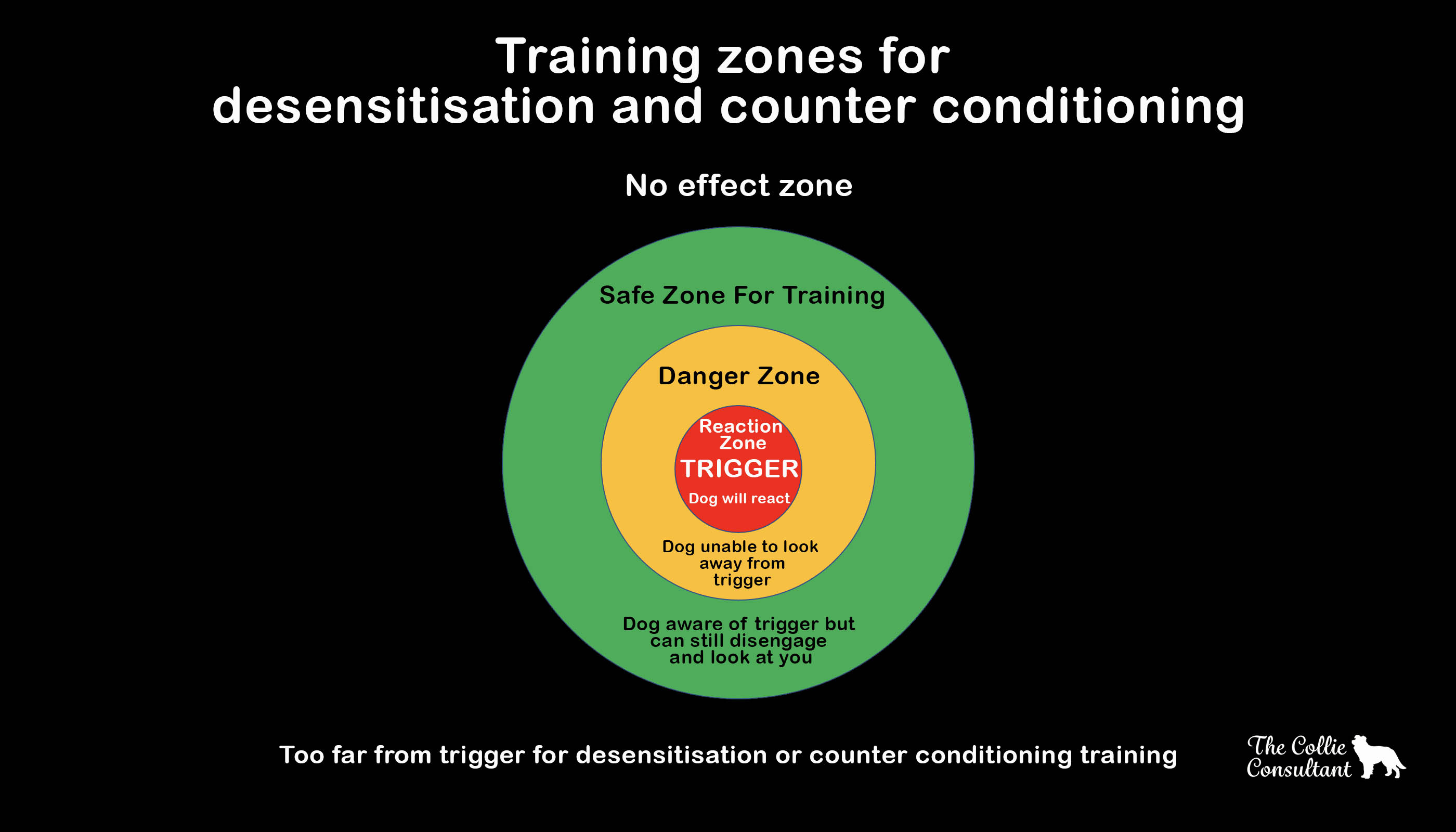
You will need to be located in the green safe zone, at which point your dog is aware of the presence of the trigger and may be very slightly worried. His behaviour should be no higher up the ladder of aggression than lip licks, yawning or sniffing (see my blog post the ladder of aggression). He must be able to disengage from the trigger to look at you when you say his name. As the trigger moves, you may have to move as well to make sure that the dog stays in the green zone in relation to the person.
These zones aren’t fixed – it depends on what else has happened in the previous days and hours. If he’s had a stressful walk, or had stressful or over-exciting things happen the same day, or the days before, his green zone may be much further away from his trigger than it will be on days when he is feeling more relaxed (read more about arousal and why it’s important). It may also depend on any aches or pains that he might be feeling on the day as well.
Ideally find somewhere to train these skills where the triggers follow a set path, eg, a road for traffic, a footpath for people and their dogs. Start as far away as you can, but where your dog can see their trigger, and walk slowly towards it.
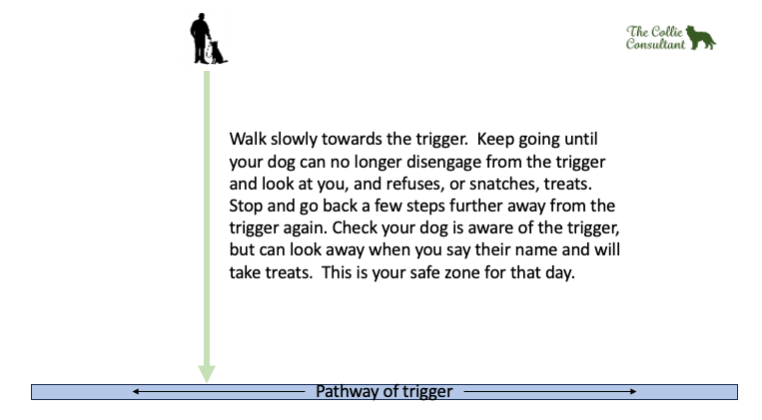
When a trigger appears, if you are in the right location, your dog will naturally want to look at it to make sure that it is not approaching. As soon as he looks, use his marker word (here I use “yip”). He should then look back at you for his treat, so give him his treat. I usually drop it on the ground to encourage sniffing which lowers arousal.
This video shows me doing this training with a border collie who was very reactive to traffic (there is intermittent traffic on a nearby road).
Whenever you use his marker word, it MUST be followed up with a treat. I use “yip” because it’s not something I use at other times of the day, so there are no times when I say it without giving my dogs a treat. This makes the training quicker because it’s clearer to the dog when he is doing the right thing. You can choose any word at all, but be consistent.
Once your dog has eaten the first treat, he will almost undoubtedly look back at the trigger again. Be ready and use your marker word as soon as he looks at it. It’s important to say the marker word while he is still looking at the trigger. When he hears his marker word, he should look back at you to get his treat. He is likely to eat the treat, then look back at the trigger and so keep repeating until the trigger has gone.
I say “Look” as well in this video, but just ignore that. The only thing you need to focus on saying when your dog looks at the trigger is your marker word, which you then follow with a treat.
If your dog does not look back at you when you say his marker word, you may be too close, may not have high enough value treats, or he may not understand that his marker word is always followed by a treat. See this Dogs Trust article for more information about marker words.
To summarise:
• Dog looks at trigger
• You say marker word
• Doglooks at you to get his treat
• You give him his treat
• Dog looks at trigger…. And so on.
What NOT to do:
• Don’t force interactions with triggers – for example, don’t ask people to feed him a treat or try and see if he will let them stroke him. Instead, completely ignore him, ask the person to stand sideways on, not look at him and stay still if he comes over to sniff them. Give him quiet praise if he does this without barking or lunging.
• Try not to tighten the lead around triggers – keep a distance away at which your dog isn’t too anxious and keep the lead loose. Behave as though nothing scary is there. Ignore any barking but praise him when he stops, move further away if you can.
• Don’t get cross or tell him off if he barks. He is already scared; he doesn’t need the pressure of his owners getting angry as well. It’s hard to do this, and it feels counter intuitive. We often feel social pressure to try and “correct” the dog but try not to do or say anything. Follow the guidelines above – move further away and drip feed.
• Don’t praise him for barking either – just ignore. If you need to use treats to stop him barking, and he will take them, don’t worry that you are reinforcing the behaviour – it’s quite difficult to reinforce a scared dog because they are unable to learn too much in one-off frightening situations.
Please remember that this is a general guide for adolescent border collies that are fearful of either people, dogs, or traffic, and is only one part of the behaviour modification plan – there will be other parts, for example increasing engagement between owner and dogs on walks, as well as other confidence-building exercises around the dog’s triggers and working further on loose lead walking. The plan for each individual dog and owner may vary and this training plan may not be safe for dogs that are very aggressive. But it gives you an idea of how we deal with fear-based aggression that start suddenly in adolescent border collies, and work with owners to help change their dog’s emotional reaction to triggers and overcome their anxieties and phobias. If you’d like further help and advice, please don’t hesitate to contact me.
